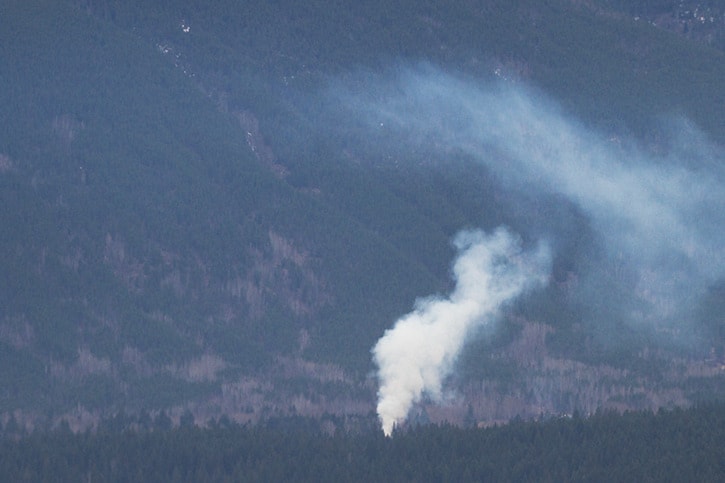Dry conditions, high temperatures, low humidity and the possibility of dry lightning – extreme fire conditions and a recipe for wildfire starts.
While the danger rating in most of the Salmon Arm Fire Zone is high, Sunnybrae was reported to be in extreme danger Monday.
And an upper low-pressure area from Oregon was expected to meet an upper high from the northeastern part of the province, with the possibility of dry lightning and thunderstorms through Thursday.
In response to the forecast and drier than normal conditions, the Kamloops Fire Centre is putting a lid on open burning at noon Friday, May 15, a month earlier than usual.
As always, Salmon Arm Fire Chief Brad Shirley says the City of Salmon Arm will follow suit, prohibiting all but small campfires.
The ban will be in place until Oct. 15, or until further notice.
Under this prohibition, members of the public will not be allowed to: burn waste, slash or other material; burn stubble or grass or use fireworks or burning barrels.
“We had three wildfires in the Kamloops Fire Centre over the weekend, all less than three hectares in size but all human caused,” says fire information officer Kelsey Winter.
The total number of wildfires since April 1, the official start of this year’s fire season, is 25. All were person-caused, including two in the Salmon Arm Zone.
Salmon Arm zone fire information officer Larry Osachoff says on April 16, firefighters were quick to extinguish a spot-sized fire in a Notch Hill logging block slash pile that somebody lit at night.
The fire is under investigation.
On April 29, logging activity 4.5 kilometres along the 130 Forest Service Road in Skimikin sparked a fire that grew to .3 of a hectare before being contained and put out.
“When they happened, it was just the start of the drying trend,” Osachoff said. “They definitely had our attention and had we not got control, they would have given us trouble.”
Campfires will still be permitted at this time, but must be no larger than one-half metre by one-half metre and must be for recreational use only or by a First Nation for a ceremonial purpose.
Winter says the Wildfire Protection Branch is also advising residents to clear out all brush from their properties.
“This is the last week people can get rid of material by Friday,” says Winter. “But they have all the restrictions; think water, tools and people on the fire the whole time.”
And when it comes to campfires, Winter reminds users to make sure they extinguish them fully. That means the ashes are cold to the touch.
A safer option is to buy a propane campfire.
But Osachoff says people need to be sure they buy only CSA-approved units and check to make sure they are in good working order as they age.
“You still have to be careful where you put them,” he says, noting the Forest Protection Branch is anxious to get the word out on the fire prohibition as soon as possible. “The long weekend in May is when people come to the Shuswap, open their cabins and camp, and the first thing they want is a campfire.”
For information, visit www.bcwildfire.ca.
Brush fire
The Salmon Arm Fire Department was alerted to a fire in a heavily forested section of a property at 2101 28th St. NE Tuesday morning.
A neighbour alerted firefighters to the fire where assistant fire chief Jim Nickles says the brush and trees had been smouldering for quite a while.
“It was most likely human caused,” he said, noting there is a children’s fort in the vicinity. “It was going pretty well; some of the trees were heavily charred.”
Firefighters extinguished the fire that grew to 15 metres by 10 metres in size.
